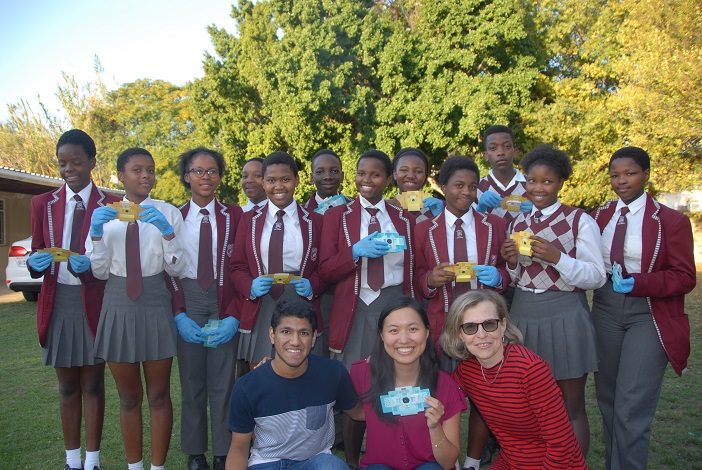Grade 10 learners from Kayamandi High and Makupula Secondary Schools in Stellenbosch were introduced to the awesome world of the very small when each of them received a Foldscope kit to “fold" their own paper microscopes and then looked at droplets from the local Krom River, as well as leaves, flower petals and even a cricket!
Called Foldscope, this paper microscope is based on the principles of paper origami, but with the optical quality similar to conventional research microscopes, i.e. magnification of 140X and 2 micron resolution. It was developed by Prof Manu Prakash, a biologist from Stanford University, as part of his efforts to produce low-cost scientific tools to globally expand access to science. At the cost of only R25 per Foldscope, having a microscope in your back pocket could become as ubiquitous as carrying a pencil around!
The workshop was organised by Prof Lydia-Marie Joubert, manager of the Electron Microscopy Unit at Stellenbosch University's Central Analytical Facilities, and took place on Friday 17 May 2019.
Prof Joubert says she supports the idea of “frugal science" and welcomes the opportunity to draw local learners into the thrill of microbiology through microscopy: “Once children has seen the invisible, they better understand daily challenges such as polluted water, or mouldy food. They also start to look out for beauty in the natural world around us."
The learners can now join the global community of “explorers" who post their images on the Microcosmos website and comment or ask questions from fellow Foldscopers, she adds.
To date, nearly half a million Foldscopes have been distributed worldwide, and the company aims to distribute one million Foldscopes by the end of 2019.
The learners were assisted by Grace Hu, a second year student from Stanford University currently on an exchange program in Cape Town, and Geevarghese Panicker from the University of Cape Town. Soon after they've folded their paper microscopes, there were several wow's as the learners first looked at a droplet of water sampled from the local Krom River. This work forms part of their curriculum, and is supported by the Kayamandi River Partnership, an initiative of the Stellenbosch University Water Institute (SUWI).
But it wasn't long before they started looking for other interesting objects to observe under the new microscopes – leaves, flower petals and even a cricket caught in the grass outside CAF house.
Each school also received a Foldscope educator's kit which includes an LED module for indoor and low light conditions, repair materials and extra materials to mount samples. A Foldscope can also be attached to a mobile phone with magnetic strips, to capture images, or to zoom in onto finer details.

This group of Gr 10 learners from Kayamandi High School couldn't wait to start exploring the world of the invisible with their newly-folded paper microscopes, called Foldscopes, while attending a workshop at Stellenbosch University's Central Analytical Facilities. They are, from left to right, Chibanda
Panashe, Esona Sogayise, Bulela Sonka, Lihle Plaatjie, Vuyiswa Mntumni,
Clarence Ruwizhi, Siyaphiwa Ntsinde, Inganathi Zinqana, Memory Gadza, Linda
Ntoyaphi, Athenkosi Mdashe and Sandisiwe Fudukile. In the front are Geevarghese Panicker (UCT), Grace Hu (Stanford University) and Prof Lydia-Marie Joubert (Stellenbosch University). Photo: Wiida Fourie-Basson

